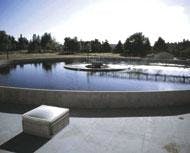Utility Optimizes Large Nutrient Removal Plant
By Bruce Willey, JB Neethling and Rob Baur
To protect water quality in the slow-moving Tualatin River, treatment plants operated by Clean Water Services (Oregon) must meet stringent nutrient limits. During the summer permit season (May through October), the 40-mgd Durham Facility must achieve an effluent phosphorus limit of 0.07 mg/L, and during late summer, it must meet an ammonia-nitrogen limit as low as 0.4 mg/L.
The nutrient limits were initially established in 1989, and Clean Water Services was given a demanding compliance schedule to upgrade its facilities. Given the limited worldwide experience with meeting very low nutrient limits, the new standards posed a challenge to the design team from HDR Inc.
Based on full-scale pilot testing conducted at the Durham Facility, the plant was initially configured to remove phosphorus using a combination of chemical precipitation, biological uptake and effluent filtration.
The activated sludge process was configured with a series of anaerobic, anoxic and aerobic cells and two internal recycle streams to provide enhanced biological phosphorus removal (EBPR), biochemical oxygen demand (BOD) removal, nitrification and denitrification. The denitrification step was not needed for permit compliance (there was no nitrate limit), but was used to recover alkalinity and reduce the cost of lime addition.
During the initial years of operation, Clean Water Services was primarily concerned with permit compliance and relied heavily on chemical precipitation for phosphorus removal. Initial alum dosages in 1993 averaged 170 mg/L; however, through continuous process improvements and optimization, the alum consumption was reduced to 60 mg/L by 1997.
By 1997, plant staff had gained confidence that they could reliably meet the effluent limits, and a team of operations specialists from HDR and Clean Water Services initiated an active program of applied research and process optimization to enhance performance and reduce operating and capital costs. This effort focused on improving EBPR performance, which had been erratic to date. It appeared that the performance of this system was compromised by inadequate concentrations of volatile fatty acids (VFAs) in the primary effluent and the presence of oxygen in the anaerobic zone.
To address the VFA issue, two primary sludge thickeners were converted to the Unified Fermentation and Thickening (UFAT) Process developed and patented by Clean Water Services. The process uses naturally occurring bacteria in sewage to provide the fuel to biologically remove the phosphorus from wastewater. Returning the elutriate from the UFAT tanks to the activated sludge process sufficiently augmented VFA levels to allow consistent biological uptake of phosphorus.
Several steps were taken to reduce the introduction of oxygen to the anaerobic zone, including elimination of primary-effluent flow-split structures that entrained air, trimming the mixer blades in the anaerobic zones to minimize air entrainment resulting from vortex formation, and investigation of nitrate levels in the return activated sludge (which turned out to be negligible).
To meet the increasingly stringent ammonia-nitrogen limits, equalization tanks were built for dewatering centrate, and this ammonia-laden stream was metered back to the activated sludge process to shift centrate ammonia loading to the low flow periods.
Also, the newest basin was designed as a plug-flow reactor (PFR). The PFR provided more stable performance, increased capacity and was better able to attenuate peak ammonia loadings. The other basins will be converted to plug flow in the future to delay the construction of an additional train. Finally, the relative sizes of the anaerobic, anoxic and aerobic basins were optimized to eliminate sludge bulking issues and maximize treatment capacity.
With these process improvements, a number of benefits have resulted:
• More stable performance during summer permit season. The improved EBPR achieves ortho-phosphorus concentrations of 0.2 to 0.3 mg/L in the secondary effluent, and the full plant achieves total phosphorus concentrations of 0.04 to 0.05 mg/L in the final effluent. Final effluent ammonia-nitrogen levels are typically below 0.05 mg/L, and nitrate-nitrogen concentrations range from 5 to 7 mg/L.
• Reduced operating costs. Alum is used in the secondary system only when EBPR in that train is producing effluent greater than 0.5 mg/L soluble phosphorous. The dosage has dropped to as low as 20 mg/L for effluent polishing. Lime usage has declined slightly. Overall sludge production has been reduced substantially, and the elimination of alum in the primary sludge has achieved a more stable solids handling system. The annual operational savings are approximately $200,000.
• Reduced capital costs. The experience gained from the process improvements has resulted in a simpler, less expensive biological nutrient removal basin design, with fewer walls, pumps, pipes and valves. The reduced sludge production has resulted in smaller solids-handling processes and has extended the capacity of existing facilities.
About the authors:
Bruce Willey is national director of wastewater out of HDR's San Diego office. JB Neethling is national director of wastewater research out of HDR's Sacramento office. Rob Baur is an operations analyst with Clean Water Services in Hillsboro, OR.

